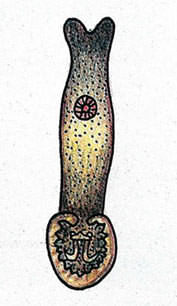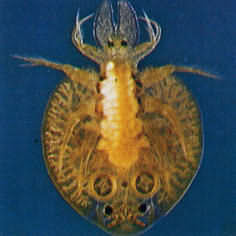Parasites that affect Koi Carp
How to identify and deal with all common parasites that can affect Koi carp.
The Macro parasites - Argulus (Fish Louse), Lernaea (Anchor worm), Gyrodactylus (Skin fluke) and Dactylogyrus (Gill fluke).
The Protozoa - Trichodina, Costia, White Spot and Chilodonella
last updated 11th February 2020
Shop online with confidence via our secure on-line shop.
We accept all major credit cards!
Review your Shopping Cart - click below.
Koi Parasites
Note that treatments listed below for various parasites are included based on our experience over a number of years in order to determine the most effective remedies. They are by no means the only effective treatments available. Some recommended treatments are no longer legally available to Koi keepers, notably Masoten, Dimlin or Supaverm. These substances all contain chemicals which can be dangerous to human health and are not licensed for use with Koi Carp.
Please do always switch off UVs or Ozone generators when using any medications as these will break down chemicals in the water very quickly and render your parasite treatment useless. When using chemicals, always ensure you know the pond gallonage, and weigh out powdered chemicals using a gramme balance to ensure correct dosing. Similarly when using liquids, measure the correct dose accurately with proper measuring cylinders or syringes. Always use latex gloves and a mask when using powdered chemicals so that chemicals cannot be ingested or come into contact with bare skin.
Once you have identified your parasite, learn how to decide on the best medication, and how to use it effectively to ensure success. See also our Medications fact sheet. for more information on medications available to the Koi keeper.

Treatment is by manual removal of the parasite with tweezers under anaesthetic, ensuring that the whole parasite is removed. To be sure of complete removal, dip a cotton bud in strong potassium permanganate solution and dab the worm with this solution whereupon it will release its grip immediately. Pond treatments include Supaverm , Dimilin and now Lice Solve. NB. Supaverm and Dimilin are chemicals that can be dangerous to human health and are not legally available as a koi treatment.
Lernaea - Anchor worm
(shown left). This parasites a common parasite on our koi which is clearly visible to the naked eye and can reach 10 to 12mm. The parasite burrows its head into the koi's tissue, under a scale and only the body and tail are normally visible. If left on the koi, secondary bacterial infections can occur at the point of contact due to the damage caused by the anchors used to attach itself. Lernaea lay eggs which can lay undetected in the pond and can hatch when conditions and water temperatures are right. Chemical treatments will not affect the viability of eggs so repeat treatments may be required to kill all generations. Normally the parasite attaches itself by the dorsal or tail fin, and is also commonly found in large numbers on the bellies of koi when they are first netted from the mud ponds.
Dactylogyrus - The Gill Fluke.
(Shown Right) Gill and Skin flukes are two of the family of monogenetic trematode genera, all of which are characterised by the large grappling hooks which are used to attach themselves to their victims. Flukes are another common parasite affecting our koi are both egg layers and live bearers. They range from 0.05 to 3.00mm long and there are actually a huge number of species in the genus. Affected koi often exhibit classic signs of irritation and flash, jump or rub themselves against objects in the pond in an attempt to rid themselves of their attackers. Flukes are not visible with the naked eye. When viewed under a microscope, the parasites are clearly visible as nearly transparent and worm like, and the hooks are alsobclearly visible. Flukes are a bit like fleas on dogs and cats and it is common to see one or two on a slide as a healthy koi can control parasite numbers and their mucus reduces parasite mobility. Treatment is therefore only necessary if flukes are seen in numbers.

Gyrodactylus - The Skin Fluke.
(Shown left) Koi suffering from infestations of gill flukes may suffer respiratory problems as the flukes begin to damage the delicate gill tissues. Secondary bacterial infection often occurs in koi left suffering from these parasites, due to the physical damage caused by the anchors. Chemical control of both types of fluke can be achieved best with Potassium Permanganate or Fluke Solve. In order to kill all generations, repeat treatments may be necessary, the frequency being dependent on temperature and chemical used. In our experience, Fluke Solve is now the best 'legal' treatment for flukes, but one dose of Supaverm will eradicate flukes very effectively.
Argulus - The Fish Louse.
(Shown Right)It is said that this parasite can be commonly introduced into our koi ponds by frogs and toads. It is however easy to detect with the naked eye especially against the background of fins and white skin of affected koi. Size varies from between 1mm and 5mm. They attach themselves to the koi by suckers which damages the skin, they also inject a poison into the body of the koi which causes inflammation, bleeding and potentially secondary bacterial infection. Pale green in colour, juveniles are more transparent. Argulus must be eradicated quickly as the parasite causes considerable physical damage to the skin which often results in subsequent ulceration of the affected areas if left untreated. The best legal chemical treatment recommended to eradicate these parasites is Lice Solve. As the parasite is easy to spot with the naked eye, physical removal is suggested before chemical treatment to remove as many as possible from affected Koi.
Protozoan Parasites
Protozoan parasites are arguably more troublesome, and cause more fatalities in Koi Carp than the Macro parasites listed above. This is primarily because they can increase in numbers very quickly indeed and therefore the damage they can cause is substantial. Protozoa multiply by binary fission. They are single celled organisms which simply divide, so one parasite becomes 2, 2 become 4, 4 become 8 and so on. It is therefore very important to identify and treat outbreaks of these parasites quickly to avoid fatalities in your Koi. All Protozoa must be identified using an appropriate Microscope.

Affected Koi may show classic signs of flashing and rubbing, may hold their fins clamped against their body and appear listless. They will also hang at the pond surface and gasp for air in severe infestations.Recommended treatments include Acriflavine with salt, Malachite Green and Formalin, Potassium Permanganate or strong Salt baths at 3% solution ( 4 1/2 oz. per gallon , or 30gm per litre) for 10 minutes.
Chilodonella (shown left)
(shown left) Chilodonella is classed as the most dangerous of the Protozoa and can cause mass fatalities especially in overstocked ponds and aquaria. It is between 40-60 microns in diameter and can be easily identified on a microscope slide using 100 x magnification. It reproduces itself by transverse fission, and the adult has a heart or ovate shape , although this is changeable, and its body is evenly covered with cilia. The parasite can actively swim short distances so healthy fish are easily infected. An infestation of Chilodonella can cause opaqueness of the skin, especially between the head and dorsal fin and in severe cases the skin can look swollen. Gills are also attacked and can be totally destroyed, quickly killing the host.
Costia
Costia (Shown right) is a minute Flagellate with 3-4 flagella. It affects both the skin and gills of Koi, and reproduces itself by binary fission, simple division (1 becomes two, two become four, etc, etc.). Infestations of this parasite can appear very rapidly indeed, and Koi suffering infestations exhibit the classic symptoms of lethargy, clamped fins, rubbing and flashing and the skin can take on a grey white opaqueness or display redness and discolouration. Costia normally only affects fish that have already been debilitated by some other cause, and can often be seen on Koi as a secondary parasite. A higher magnification must be used to view these parasites (300 x) and staining is recommended along with a high contrast for positive identification. Even then identification can be tricky, as these parasites are very small indeed and can exist just in patches on the skin and gills of the affected fish.

Costia is classed as a cold water parasite and is not normally able to survive temperatures in excess of 85 deg F. Recommended treatments include Potassium Permanganate, Acriflavine with salt and strong salt baths of 3% ( 4 and one half oz. per gallon )for 10 minutes

A magnification of 100 to 200 x is required to view this parasite. Recommended treatments are Acriflavine with salt and Potassium Permanganate.
Trichodena
(shown left)Trichodina is one of the easiest protozoan parasites to detect under the microscope as it is almost perfectly round with hundreds of hooks which resemble cilia round its periphery and it constantly rotates as it moves through the mucus, causing tissues damage. It attacks both skin and gill tissues of our Koi, and can often cause more damage to gills than realised. Classed as a warm water parasite, it can survive for some time without a host. It causes vegetation of the skin giving rise to a grey white opaque appearance on the body of infected Koi which exhibit the classic symptoms of flashing, rubbing and lethargy.
Whitespot

Ichthyophthirius multifilis (Ich) - White spot , one of the ciliates, showing the classic horseshoe shape macronucleus (above) is classed as a large protozoa, the affects of which can be detected by the naked eye on infected fish by the appearance of hundreds of tiny white spots where the parasite has bored through the skin of the host. The adult parasite drops off the host, surrounds itself with a capsule and fixes itself to a plant or rock. Inside the capsule the parasite divides and multiplies and eventually 250 - 1000 tiny 'swarmers' are released and these then swim off in search of a new host. The swarmers typically attack the dorsal and caudal fins of Koi, although gills and body are also affected. The swarmers burrow through the surface of the skin and so the parasite resides in the body and not on the body of infected fish.
Chemical treatments have to be long lasting and repeated several times to rid the fish population of these parasites. Recommended treatments are Acriflavine with salt ,Malachite Green with salt, Malachite and Formalin, and prolonged use of salt at one oz per gallon. Chemical treatments other than Acriflavine should be repeated at least twice to ensure complete eradication.

Shown above - White spot on microscope slide. The complex nature of the life cycle of white spot can render it difficult to treat as it is only the free swimming swarmers that can be killed with chemical treatments. Once the swarmers attach themselves to our Koi, until they detach as adult parasites can take between 4 days at 27 deg C (80 deg F) and up to 4 to 5 weeks at 10 deg C (50 deg F). The parasite becomes encapsulated in only one hour after leaving the host. Newly produced swarmers can however only live without a host for up to 55 hours maximum, so by simply removing Koi from a pond for three days, it can be cleared of the parasite completely.



